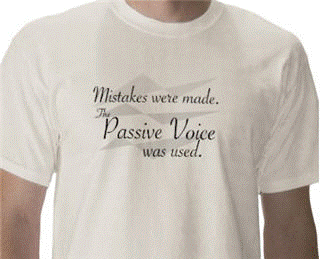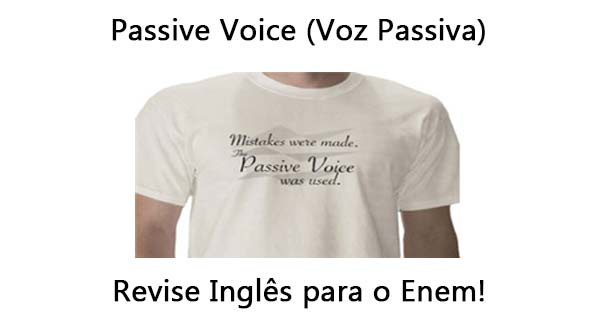QUER LER MELHOR UM TEXTO EM INGLÊS? ENTÃO LEIA ESSE POST SOBRE VOZ PASSIVA E AMPLIE SUAS CHANCES DE CONQUISTAR UMA VAGA NUMA BOA UNIVERSIDADE!
A prova de inglês do Enem se caracteriza por ter bastantes textos, principalmente reportagens. Por isso, é importante estudarmos a voz passiva, já que ela é bastante utilizada em textos técnicos, reportagens e textos formais.
A voz passiva é usada quando o foco não é o sujeito, ou seja, quem fez a ação, e sim, o objeto. Veja o exemplo a seguir: Leonardo da Vinci painted Mona Lisa. (Leonardo da Vinci pintou o quadro Mona Lisa).
Neste exemplo, o foco é o sujeito, Leonardo da Vinci. Agora, leia este exemplo: Mona Lisa was painted by Leonardo da Vinci. (Mona Lisa foi pintada por Leonardo da Vinci).

Neste segundo exemplo, o interesse é a pintura, ou seja, o objeto e não o sujeito.
Algumas considerações sobre a voz passiva:
1- Usamos o verbo na voz ativa para dizer o que o sujeito fez:
My father was an architect. He built his house in 1962.
(Meu pai era arquiteto. Ele construiu sua casa em 1962)
It’s a big company. It employs almost one thousand people.
(É uma empresa grande. Ela emprega quase mil pessoas).
2- Usamos o verbo na voz passiva para dizer o que aconteceu com o sujeito:
This house was built in 1962.
(Essa casa foi construída em 1962).
Almost one thousand people are employed by the company.
(Quase mil pessoas trabalham nessa empresa).
3- Quando usamos a voz passiva, quem ou o que causa a ação não é conhecido ou não é importante.
Is this room cleaned every day?
(o quarto é limpo todo dia?)
Coffee is grown in Brazil.
(Café é cultivado no Brasil.).
4- A forma da voz passiva em inglês é:
Verbo TO BE + verbo no PARTICÍPIO PASSADO
a) Simple present:
The maid cleans the room every week.
(A arrumadeira limpa o quarto toda semana.)
The room is cleaned every week.
(O quarto é limpo toda semana.)
b) Simple past
Somebody cleaned the room. (Alguém limpou o quarto.)
The room was cleaned. (O quarto foi limpo.)
c) INFINTIVO:
Somebody will clean the room later. (Alguém limpará o quarto mais tarde.)
The room will be cleaned later. (O quarto será limpo mais tarde.)
d) Present Perfect:
The room looks tidy. Somebody has cleaned it. (O quarto parece arrumado. Alguém o limpou.)
The room has been cleaned. (O quarto foi limpo.)
e) Past Perfect
Somebody had cleaned the room. (Alguém tinha limpado o quarto.)
The room had been cleaned. (O quarto tinha sido limpo.)
f) Present Continuous
Somebody is cleaning the room at the moment. (Alguém está limpando o quarto neste momento.)
The room is being cleaned at the moment. (O quarto está sendo limpo no momento.)
g) Past Continuous
Somebody was cleaning the room. (Alguém estava limpando o quarto.)
The room was being cleaned. (O quarto estava sendo limpo.)
Aprenda mais sobre a passive voice / voz passiva com a nossa aula:
Agora que você já sabe tudo sobre passive voice, que tal testar seus conhecimentos?
QUESTÃO 1 – (Unesp) Indique a alternativa que expressa o mesmo significado de:
When children watch TV, they encounter a wide range of places, people,and information.
a) When children watch TV, a wide range of places, people, and information will be encounter
b) When children watch TV, a wide range of places, people, and information are encountered.
c) When children watch TV, a wide range of places, people and information is encountered.
d) When TV was watched, a wide range of places, people, and information are encountered by children.
e) A wide range of places, people, and information will be encountered when children watched TV
QUESTÃO 2. (UEM) Indicate the passive form of “The author wrote The Old Man and the Sea.”
a) The author has written The Old Mand and the Sea.
b) The Old Man and the Sea was being written by the author.
c) The Old Man and the Sea was written by that author.
d) The Old Man and the Sea wrote that author.
e) B and C are correct.
GABARITO:
QUESTÃO 1 – B
QUESTÃO 2 – C


